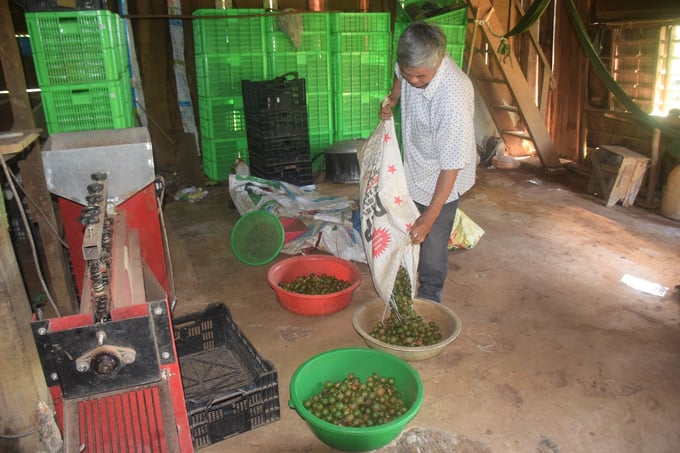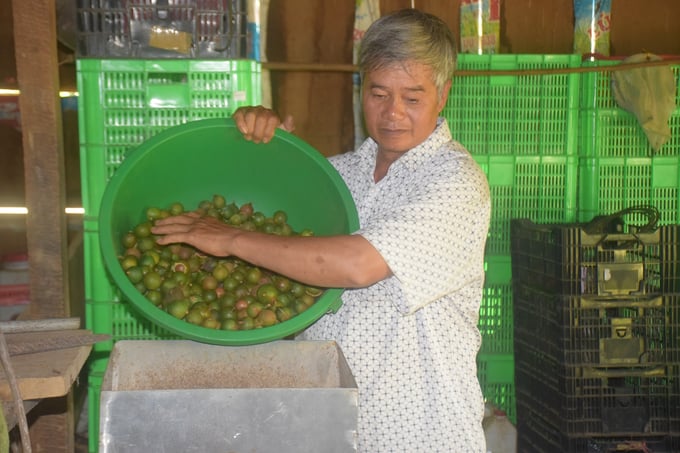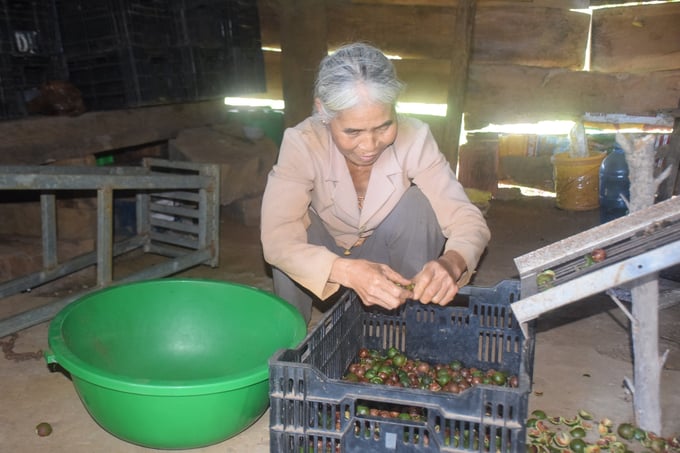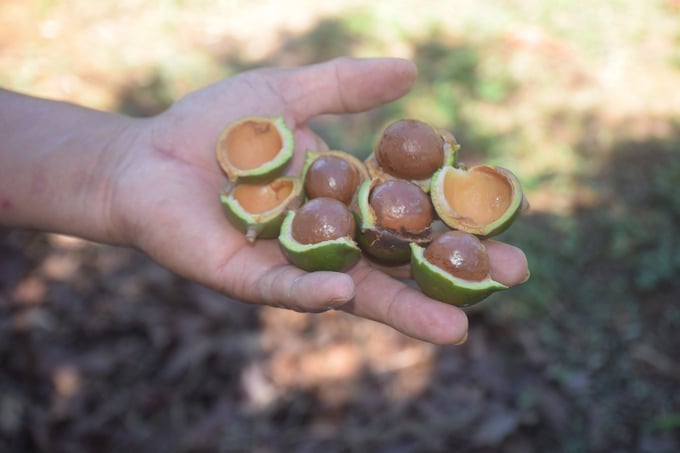November 25, 2025 | 13:40 GMT +7
November 25, 2025 | 13:40 GMT +7
Hotline: 0913.378.918
November 25, 2025 | 13:40 GMT +7
Hotline: 0913.378.918
Vinh Thanh district (Binh Dinh) has denied the expansion of the macadamia plantation to other areas due to the unsuitable climate, stating that macadamia trees can only thrive in Vinh Son commune. The fact demonstrates that macadamia trees have specific weather and soil requirements for sub-climates.
Ten years have passed since macadamia trees were introduced to the Vinh Son upland, and six years since Dan Van Khanh harvested macadamia fruits from his first sowing area in K8 village. Khanh has now confirmed that the soil and climate of the Vinh Son upland are suitable for macadamia trees, allowing them to thrive and produce multiple crops on a cycle-by-cycle basis, along with excellent yields, consistent output, and a stable selling price.

The area of macadamia planted in 2012 by Mr. Dang Van Khanh in Vinh Son upland commune (Vinh Thanh district, Binh Dinh) although not properly cultivated, currently yields 20kg of fruit/tree/year. Photo: VDT.
According to Khanh, the first two hectares of macadamia trees that were planted in K8 village (Vinh Son commune) in December 2012 began producing fruit in September 2017. Since then, he has expanded his macadamia grove by 0.5 to 1 hectare, bringing the total area to 6 hectares.
From December of the previous year to February of the following year, the macadamia tree blooms and bears fruit. From April to May, macadamia processors have come to the garden to place money to purchase.
According to Khanh's calculations, his first macadamia acreage was planted on Vinh Son land, although it was not properly cultivated, with only about 15 kg of manure per tree per year, 1 kg of NPK fertilizer, and he only watered it twice a year during the dry season, but each tree produced 20 kg of fruit annually. From the sixth year on, each tree must produce 45-50 kg of fruit annually if intensive agriculture is practiced correctly.

The early ripe macadamia pods fell to the ground and were picked up by Mr. Khanh and his wife and put in the shelling machine to sell to traders. Photo: VDT.
Macadamia nuts are currently priced at 90,000 VND per kilogram of shelled fruit. The semi-intensive macadamia acreage yields a yearly income of approximately 1,8 million Vietnamese Dong per 20 kg of peeled fruit per tree. Each hectare of macadamia nuts generates a revenue of approximately 500 million VND. This is the money of dreams for the highlanders of Vinh Son.
According to Khanh, the price of peeled macadamia nuts in 2017 was only 75,000 VND per kilogram. Three years ago, the price of macadamia fluctuated between 85,000 and 120,000 VND per kilogram, and at the start of the 2023 macadamia harvest, the price of peeled fruit was 90,000 VND per kilogram. There is no tree on this Vinh Son property with superior economic efficacy, as prices have been fairly stable for many years.
Despite having benefited from macadamia for six years, Dang Van Khanh advised farmers not to cultivate these trees in unsuitable environments. It is essential to select high-quality seedlings from trustworthy suppliers recommended by specialized agencies and the Vietnam Macadamia Association.

Mr. Dang Van Khanh put macadamia into the shelling machine. Photo: VDT.
In Vinh Son, many farmers with kaingin land came to Mr. Khanh's macadamia orchard to ask for the purchase of seedlings for sowing after observing the success of his macadamia garden. However, he did not sell. Because he knew that cultivating macadamia trees from seedlings created from tree branches would only yield firewood, he knew that the tree would not produce fruit. Mr. Khanh was once taken by the Vietnam Macadamia Association to the gardens specializing in the production of macadamia seedlings, so he was aware that the production process to produce quality seedlings was extremely complex.
"I am available and willing to share my knowledge with anyone interested in growing and caring for macadamia trees. Every day, I exchange information with the Vietnam Macadamia Association on Zalo group. The Association has visited my macadamia model numerous times," Khanh revealed.
According to Le Minh Thong, Vice Chairman of the People's Committee of Vinh Thanh district (Binh Dinh), macadamia trees have been flourishing in this district for just over a decade. This is a new facility, so the functional sector of the neighborhood's development is extremely circumspect.

Khanh's wife peeled the macadamia fruits. Photo: VD.T.
According to Vice Chairman Thong, after determining that macadamia trees are suitable for Vinh Son's soil and climate, the district government of Vinh Thanh will soon mobilize the people of Vinh Son to convert crops and expand macadamia acreage in this highland commune, emphasizing the importance of selecting and purchasing high-quality seedlings to ensure efficiency.
Vice Chairman Thong added that the area under afforestation and other inefficient trees that can be converted to macadamia trees in the Vinh Son commune is currently estimated to be approximately 2,000 hectares. The district will communicate with and mobilize individuals to cultivate macadamia in order to enhance their livelihoods. Cassava yields approximately 50 million VND/ha compared to 50 - 70 million VND/ha for 1 hectare of planted forest after 5 years of harvesting and deducting all expenses. However, 5 years after sowing, 1 hectare of macadamia will bear fruit and generate up to hundreds of millions of dong per hectare per year.

Currently, peeled macadamia nuts in Vinh Son are priced at 90,000 VND/kg. Photo: VDT.
According to Bui Tan Thanh, Chairman of the Vinh Thanh District People's Committee, upon realizing that macadamia trees planted in Vinh Son highland commune bore fruit, Mr. Thanh brought the seeds to plant in Vinh Thanh town and neighboring communes, but none of them bore fruit. Since then, the district of Vinh Thanh has determined that macadamia trees can only be grown in the commune of Vinh Son due to the soil and climate conditions there.
Translated by Linh Linh

(VAN) Heavy rains make aquatic species more vulnerable to disease. Proactive water management and high-tech systems help farmers prevent outbreaks and protect yields.

(VAN) Greenhouses are shifting production mindsets in Binh Lu commune, enabling farmers to ‘weather the sun and rain’ and secure stable vegetable harvests throughout the year.

(VAN) Green transition is crucial for the Mekong Delta amid climate change and stricter standards, offering a path toward sustainability.

(VAN) Dong Thap promotes agricultural restructuring, forms large specialized farming zones, raises the value of agricultural products and develops toward ecological and high-tech directions.
/2025/11/22/4018-4-213342_747.jpg)
(VAN) The Mekong Delta Agricultural Experts Club has attracted 143 experts and researchers to participate in providing consultancy and contributing initiatives to the development of one million hectares of high-quality rice.

(VAN) Ca Mau’s development of OCOP products opens a path to increasing cooperatives value, helping boost income, expand markets, and affirm collective economy's role.

(VAN) Turning seemingly ordinary coconut shells into unique jewelry and artwork, Nguyen Bang Nhi spreads the value of local culture through her brand, Cocohand.